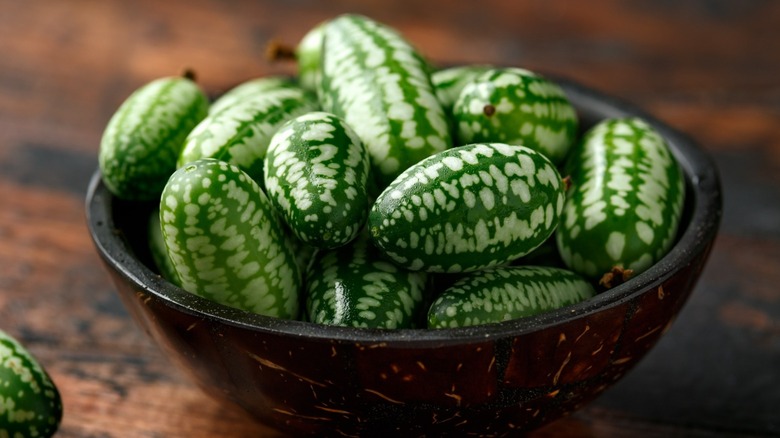Why This Cucumber Is Often Mistaken For A Tiny Watermelon
If you spied them at your local farmer's market you might think they were melons for the likes of Stuart Little. Small, green, and variegated, these oblong fruits look a lot like tiny watermelons — that is, until you slice into them. Inside this grape-sized, tangy mini-melon imposter, you won't find the requisite jewel-tone red you might expect, dotted with black seeds. What you'll find instead is the tart green flesh and white seeds of the cucamelon (Melothria scabra). Sometimes referred to as Mexican sour cucumbers, Mexican miniature watermelon, Mexican sour gherkin, and sandía ratón or "mouse melons", these baby melons are said to taste exactly like cucumbers with just a tang of lime.
Native to Central America, these little beauties are an instant favorite when pickled or served as a garnish in sunny cocktails. Nutritionally they've earned their seat at the superfoods table, packed with vitamins, minerals, antioxidants, and fiber. Better Homes and Gardens reports that the nutrients found in cucamelons can even help to lower the risk of heart disease, stroke, and cancer.
But it's the bright citrus-tinged cucumbery taste that really makes this fruit shine in cool summer salads. Try them in this Thai-inspired Smashed Cucumber Salad, or swap out traditional cucumbers for cucamelons in your most beloved watermelon feta salad recipe.
What are cucamelons and where can I get them?
If you think these bite-sized perennials are just a hybrid of watermelons and cucumbers, think again. While all three reside in the same family (Cucurbitaceae) of flowering plants, all three are also of a different genus from one another — watermelon (Citrullus), cucumber (Cucumis), and cucamelon (Melothria).
Award-winning gardening author Niki Jabbour notes that cucamelons can be hard to find, and when you do find them, they can be very expensive. Easy to grow, Jabbour advises growing this hearty drought-tolerant crop yourself. Better Homes and Gardens reports that cucamelons do best in warm, frost-free environments, though they advise that gardeners in cooler climates can still enjoy growing this mini-melon by potting them and rotating them indoors to warm at night when temperatures drop. Rarely bothered by disease or insects, cucamelons take up to 75 days to mature and can be germinated from seeds.
But buyer beware, as Atlas Obscura points out, the cucamelon's disguise works to the advantage of unscrupulous seed sellers, who pass them off as miniature watermelons to buyers who are fooled by the cucamelons' outward appearance and fake photos showing garnet-red insides.
Whether you grow them yourselves or seek them out from a local grower, there's no disputing the big bursting flavor and nutritional power of this cute little fruit.

